Tea for the New Year of the Snake
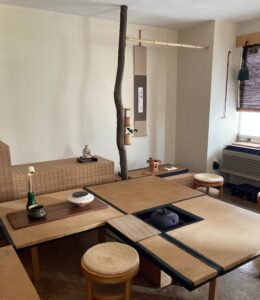
Ga-ran-dō, 伽蘭洞, Help-orchid-cave; with utensils for the New Year 2025, Mi-doshi, 巳年, Snake-year. The traditional lunar New Year of the Snake begins on January 29, 2025.
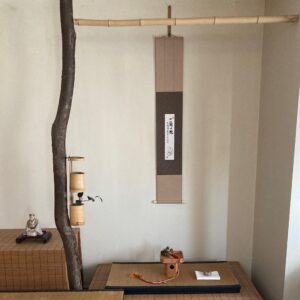
Toko-no-ma, 床の間, floor’s-room; kake-mono, 掛物, hang-thing, tan-zaku, 短冊, short-volume, kake hana-ire, 掛花入れ, hang flower-receptacle, ni-jū-giri, 二重切, two-tier-cut, ka-gura suzu, 神楽鈴, god-music bells, and san-bō, 三方, three-directions.
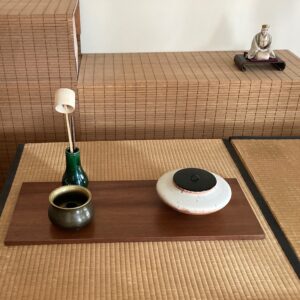
Cha-dō-gu, 茶道具, tea-way-tools: naga-ita, 長板, long-board, walnut, by Thomas Hucker, New Jersey; mizu-sashi, 水指, water-indicate, stoneware with ‘Shi-no’, 志野, Aspire-field, orange to white glaze, American pottery, with black-lacquered lid; ceramic shaku-tate, 杓立, ladle-stand, with openwork of ‘tsubo–tsubo’, ツボツボ, jar-jar, Sen family design, with green glaze, stamped ‘Raku’, 楽, Pleasure; H. 5.5 sun kane-jaku.
The hi-bashi, 火箸, fire-rods, in the shakutate have wooden handles which are Rikyū’s choice for use with the sunken ro, 炉, hearth. Ideally, kazari hi-bashi, 飾火箸, display fire-rods, are preferred, however lacking the ‘correct’ utensils should not prevent one from presenting Chanoyu.

Tan-zaku, 短冊, short-volume; ‘Ichi-go ichi-hebi’, 一期一蛇, 1 time 1 snake, with painting of a white snake, by Tsuji Jō-kan, 辻常閑, Crossroads Ever-leisure, Kichi-jō-ji, 吉祥寺, Luck-happy-temple, Dai-toku-ji-ha, 大徳寺派, Great-virtue-temple-branch, Gifu.
L. 9.5 sun kujira-jaku: wordplay on 9 5 kyū-go, 救護, salvation-protect. Created for the Snake Year 1989.
Kōgō for ro: ne-buto, 根太, root-grand, carbuncle; ceramic, covered container, ki-Se-to yaki, 木瀬戸焼, yellow-Rapids-door fired; diam. 2 sun kane.
This kōgō is modeled on hōju, 宝珠, treasure-jewel, used with neri-kō, 練香, kneaded-incense, and made for a Dragon Year or for a Snake Year as both dragon and snake are identified with the hōju.
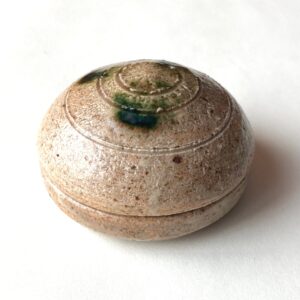
Similar kōgō have the addition of three or five tsume, 爪, talons, which are specifically related to dragons, whereas hōju without talons may relate to the snake.
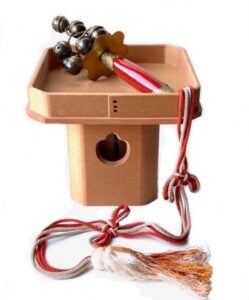
The shin-en-rei, 神苑鈴, god-garden-bell, is a cluster of ten spherical brass bells on a spiral stalk mounted on a wooden handle with long trailing red and white cords. This cluster of bells is on three tier wire: two on top, three on the middle and five on the bottom.
The cluster of bells is shaken at Shintō shrines to bless people. The shaken bells emulate Ame-no-uzume no Mikoto, 天之鈿女の命, Heaven’s Narrow-woman’s Lord, shaking reeds, which lured the Sun Goddess, Ama-terasu, 天照, Heaven-brighten, out of the Rock Cave of Heaven. The red and white cords manifest the concept of kō-haku, 紅白, red-white, which is emblematic of the union of In, negative, and Yō, positive.
The sanbō is made of wood and has eight sides, there are several interpretations of the three openings. One idea is that they represent the three offerings: foods from the sea, the plain, and the mountain. These three foods are presented in the Ha-ssun, 八寸, Eight-span, course of the Kai-seki, 懐石, Heart-stone, meal of a Cha-ji, 茶事, Tea-matter. The original hassun bon was inspired by the sanbō tray at Kasuga Tai-sha, 春日大社, Spring-sun Great-shrine. The shō-men of the top of the sanbō in the photograph is facing away from the viewer. The rules of shōmen with regard to utensils of Chanoyu include: maru mae kaku muko, 丸前角向, round front cornered opposite.
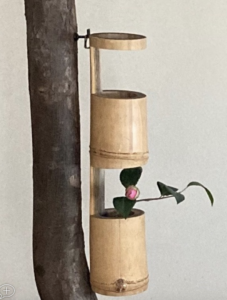
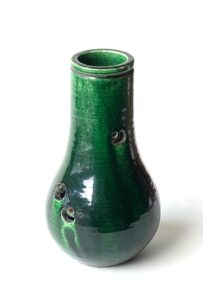
The shaku-tate, 杓立, ladle-stand, has openings, each of which form the shape of a lid-less mizu-tama, 水玉, water-jewel. The ceramic open-work motifs are variations on the ‘tsubo-tsubo mon’, つぼつぼの紋, jar-jar crest, of the three Sen families. As with the three family crests, two of the tsubo are near each other, while, as a whole, there are three free tsubo representing the three Sen families. The tsubo can be identified with the hōju.
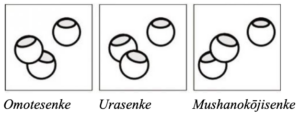
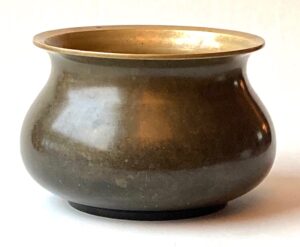
The ken-sui, 建水, build-water, is in the form of ‘e-fugo’, 餌畚, food-hamper, Kara-kane, 唐銅, Tang-copper, bronze. The kensui is also called koboshi, 零し, spiller, which is wordplay on ko-bō-shi, 小法師, little-law-master, minor Buddhist official. The Kanji for koboshi, 零, also means zero. There may be wordplay on fugo; fu-go-sen, 不語仙, no-language-hermit, which is a word for the lotus flower.
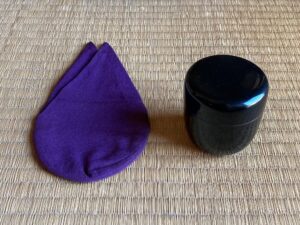
It is advisable to use a very familiar utensil, like the Rikyū-gata chū-natsume, when many Tea utensils are kawatteiru, 変わっている, unusual, uncommon, etc. The Ōtsu bukuro, designed and originally made by by Sō-on, 宗恩, Sect-gratitude, Rikyū’s wife, is modeled after a rice bag.
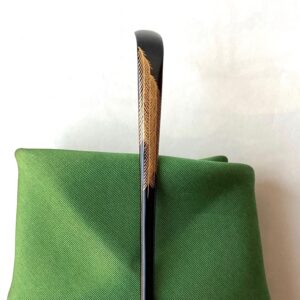
A branch of budding willow tied in a loop, musubi-yanagi, 結び柳, tied-willow, is displayed in the tokonoma for a New Year’s Tea gathering. Curiously, the long slender body of the chashaku with its curved scoop is physically most like a snake.
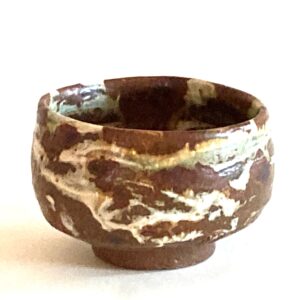
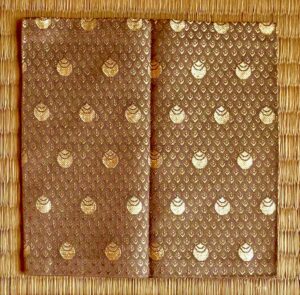
A kobukusa is used to hold a cha-wan, 茶碗, tea-bowl, when the bowl is not made in the manner of Raku, 楽, Pleasure. There are exceptions.
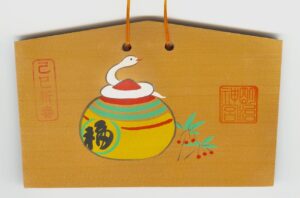
E-ma, 絵馬, picture-horse, pentagonal cedar board with a design of a white hebi, 蛇, snake, coiled on a multi-colored hō-ju, 宝珠, treasure-jewel, with the Kanji, fuku, 福, fortune. With Go-shu-in, 御朱印, Hon.-vermilion-stamp, of Mei-ji Jin-gū, 明治神宮, Bright-peace God-palace, and stamped, Tsuchinoto-Mi Shin-shun, 己巳新春, Earth’s Younger Brother-Snake New-spring, 1989.
For further study, see also: New Year Collection

